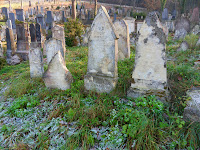 Boskovice is about 35 km (22 miles) from Brno. It's in the north part of the South Moravian region. It's a cute little town with a castle, a chateau, a preserved Jewish quarter and one of the largest Jewish cemeteries in the Czech Republic.
Boskovice is about 35 km (22 miles) from Brno. It's in the north part of the South Moravian region. It's a cute little town with a castle, a chateau, a preserved Jewish quarter and one of the largest Jewish cemeteries in the Czech Republic. The Gothic-Renaissance castle dates back to the mid 13th century. From up at the castle there is a good view of the Malá Haná and Drahany Highlands.
The Gothic-Renaissance castle dates back to the mid 13th century. From up at the castle there is a good view of the Malá Haná and Drahany Highlands.
The chateau's origins go back to the 1820s. After 1991, it was finally returned to the original owners – the House of Mensdorff-Pouilly.
There is also a greenhouse. Unfortunately, in November everything is closed so a future trip needs to be planned in the Spring in order to see the interiors of the castle, chateau and greenhouse.

At the lower part of the main town square is the St. James the Elder church. The first written reference to the church was in 1346. Around 1500 it was reconstructed and in 1845-1847 it was remodeled in Gothic style.
 Boskovice used to have one of the largest communities in Moravia. At its height there were 1,810 Jews living here. During the first Czechoslovak Republic there were only about 460 in Boskovice.
Boskovice used to have one of the largest communities in Moravia. At its height there were 1,810 Jews living here. During the first Czechoslovak Republic there were only about 460 in Boskovice.
In 1942, the Jews were sent off to concentration camps and only 14 people returned. Today's Jewish Quarter is made up of 13 streets and 79 preserved houses. Over 25 buildings have been declared national monuments and are protected by the Czech government.

The Major Synagogue was built in 1639.

The Jewish cemetery is believed to be the third-largest in the country. The 2,500 marble, granite, limestone and sandstone tombstones date back from 1670 to the 2oth century.

The tombstones are written in Hebrew, German and Czech. Some are in better shape than others.
Near the town, there's even a Wild West town complete with Cowboys and Indians. I'm told it is one of the most popular Wild West cities in the ČR. I'm surprised that there's one, much less more than one, but oh well. I will be sure to check it out once it warms up a bit.
























No comments:
Post a Comment